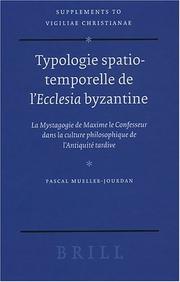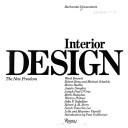| Listing 1 - 10 of 57 | << page >> |
Sort by
|
Book
ISBN: 9788899776244 8899776245 Year: 2019 Publisher: Roma CURA.
Abstract | Keywords | Export | Availability | Bookmark
 Loading...
Loading...Choose an application
- Reference Manager
- EndNote
- RefWorks (Direct export to RefWorks)
Published as the culmination of an important shift in Patrizio Di Massimo's practice, this monograph - the first in the artist's career - offers an in-depth survey of five years of his paintings. The multiple aspects of his work, from theatricality to the erotic, from self-representation to historical references, are analyzed through texts by: Marcella Beccaria, Diana Campbell Betancourt, Fabio Cherstich, Than Hussein Clark, Vincenzo de Bellis, Milovan Farronato, Nicoletta Lambertucci, Matthew McLean, João Mourão and Luís Silva, Hans Ulrich Obrist, Paulina Olowska, Alessandro Rabottini, Mathilde Rosier.
Book
ISBN: 9789077459898 Year: 2013 Publisher: Amsterdam Roma
Abstract | Keywords | Export | Availability | Bookmark
 Loading...
Loading...Choose an application
- Reference Manager
- EndNote
- RefWorks (Direct export to RefWorks)
kunst --- eenentwintigste eeuw --- beeldhouwkunst --- installaties --- Bartolini Massimo --- Italië --- 7.071 BARTOLINI --- Exhibitions --- Italië --- Bartolini, Massimo
Book
ISBN: 1532666004 9781532666001 9781620322000 1620322005 9781498286572 1498286577 Year: 2019 Publisher: Eugene
Abstract | Keywords | Export | Availability | Bookmark
 Loading...
Loading...Choose an application
- Reference Manager
- EndNote
- RefWorks (Direct export to RefWorks)
Maximus, --- Maximus Confessor --- Maximus --- Maxime le Confesseur --- Maximus der Bekenner --- Maximus the Confessor --- Massimo il Confessore --- Maksim Ispovednik --- Maksim Spoznavalec --- Maximos Homologetes --- Maxim Mărturisitorul --- Hagios Maximos, --- Maksim, --- Makʻsime Aġmsarebeli, --- Massimo Confessore, --- Massimo il Confessore, --- Maxim, --- Maxime le Confesseur, --- Maximos Confessor, --- Maximos, --- Maximos ho Gkraikos, --- Maximos ho Homologētēs, --- Maximus Confessor, --- Maximus of Constantinople, --- Sfântul Maxim,
Book
ISBN: 3839452937 9783839452936 Year: 2020 Publisher: Bielefeld
Abstract | Keywords | Export | Availability | Bookmark
 Loading...
Loading...Choose an application
- Reference Manager
- EndNote
- RefWorks (Direct export to RefWorks)
Raum kann integraler Bestandteil einer Komposition sein - davon handelt der dritte Teil der Trilogie zum hörbaren Raum und seiner Technologie. Im Mittelpunkt der Studie steht mit Nonos Prometeo eine der bekanntesten und komplexesten Raumkompositionen des 20. Jahrhunderts. Ausgangspunkt der Untersuchung ist die Rekonstruktion des hörbaren Klangs der im speziellen Holzbau von Renzo Piano verteilt aufgestellten Musiker, Sänger und Lautsprecher bei der Uraufführung 1985. Die Analyse der Raum-Klang-Verhältnisse zeigt, dass die elf Teile des Prometeo aus sich ständig wandelnden Raumklangskulpturen bestehen, die mit den Texten aus Massimo Cacciaris Libretto interagieren.
Elektroakustische Musik; Raumkomposition; Luigi Nono; Prometeo; Renzo Piano; Massimo Cacciari; Raum; Klang; Text; Komposition; Musik; Kulturgeschichte; Musikwissenschaft; Musikgeschichte; Electroacoustics; Room Composition; Space; Sound; Composition; Music; Cultural History; Musicology; Music History --- Composition. --- Cultural History. --- Luigi Nono. --- Massimo Cacciari. --- Music History. --- Music. --- Musicology. --- Prometeo. --- Renzo Piano. --- Room Composition. --- Sound. --- Space. --- Text.

ISBN: 9004142304 9786610867516 9047406850 1280867515 143370434X 9789004142305 9789047406853 9781433704345 Year: 2005 Volume: 74 Publisher: Leiden ; Boston : Brill,
Abstract | Keywords | Export | Availability | Bookmark
 Loading...
Loading...Choose an application
- Reference Manager
- EndNote
- RefWorks (Direct export to RefWorks)
This study addresses the philosophical context of the Mystagogy of Maximus the Confessor. It examines how the Byzantine monk integrates Neoplatonist topics when exposing one of the most important feature of his religious conception of the physical world or cosmology. The volume contains three chapters. The first one compares the purpose of the Mystagogy and the program of the philosophical training in late Antiquity. The second consists of two parts : (1) study of the use of the Aristotelian categories of 'when' and 'where' in the 'Ambiguum 10' of Maximus in order to analyse the status of ecclesiastical architecture and the nature of the liturgical 'synaxis' of the church (chapter 3); (2) study of the development of the categories of space and time in the works of the Neoplatonist Greek commentators of Plato and Aristotle such as Jamblichus, Proclus, Simplicius and Damascius. The third chapter offers the first extended examination of the metaphysical status of the 'ecclesia' and its dynamic activity compared to the metaphysical status of space and time required for the explanation of the Neoplatonist physical world system. Henceforth, the 'ecclesia' of the Mystagogy can be considered as the type of the providential action of God. This book provides many important new perspectives for reading the works of Maximus the Confessor, especially the Mystagogy, not only for theologians, but also for scholars interested in late Antique and Byzantine philosophy. Cette étude, consacrée au contexte philosophique de la Mystagogie de Maxime le Confesseur, examine comment le moine byzantin intègre certains concepts tirés du Néoplatonisme quand il expose les plus importantes lignes de sa conception religieuse du monde physique. Ce volume contient trois chapitres. Le premier compare l'objectif de la Mystagogie et le programme philosophique des écoles de l'Antiquité tardive. Le second comporte deux parties : (1) une étude de l'emploi des catégories 'quand' et 'où' dans l' Ambiguum 10 ' de Maxime avec pour objectif l'analyse du statut de l'architecture ecclésiale et l'analyse de la nature de la synaxe liturgique (chapitre 3); (2) une étude du développement des catégories de lieu et de temps dans les Oeuvres des Commentateurs néoplatoniciens de Platon et d'Aristote, tels Jamblique, Proclus, Simplicius et Damascius. Le troisième chapitre offre la première étude approfondie du statut métaphysique et dynamique de l' ecclesia compare au statut métaphysique du lieu et du temps requis par l'explication néoplatonicienne du monde physique. L' ecclesia de la Mystagogie sera ainsi considerée comme le type de l'action providentielle de Dieu dans le monde créé. Ce livre fournit une nouvelle perspective de lecture des Oeuvres de Maxime le Confesseur et devrait intéresser tant les théologiens que les scientifiques consacrant leurs travaux à l'Antiquité tardive et à la philosophie byzantine.
Space and time --- Church. --- Religious aspects --- Orthodox Eastern Church. --- Maximus, --- Orthodox Eastern Church --- Liturgy --- Church --- Ecclesiastical theology --- Ecclesiologie --- Ecclesiology --- Ecclésiologie --- Eglise --- Kerk --- Kerk [Leer over de ] --- Leer over de Kerk --- Theology [Ecclesiastical ] --- 276 =75 MAXIMUS CONFESSOR --- Griekse patrologie--MAXIMUS CONFESSOR --- Space of more than three dimensions --- Space-time --- Space-time continuum --- Space-times --- Spacetime --- Time and space --- Fourth dimension --- Infinite --- Metaphysics --- Philosophy --- Space sciences --- Time --- Beginning --- Hyperspace --- Relativity (Physics) --- Theology, Ecclesiastical --- People of God --- Theology --- Religious aspects&delete& --- Liturgy. --- Maximus Confessor --- Maximus --- Maxime le Confesseur --- Maximus der Bekenner --- Maximus the Confessor --- Massimo il Confessore --- Maksim Ispovednik --- Maksim Spoznavalec --- Maximos Homologetes --- Maxim Mărturisitorul --- Hagios Maximos, --- Maksim, --- Makʻsime Aġmsarebeli, --- Massimo Confessore, --- Massimo il Confessore, --- Maxim, --- Maxime le Confesseur, --- Maximos Confessor, --- Maximos, --- Maximos ho Gkraikos, --- Maximos ho Homologētēs, --- Maximus Confessor, --- Maximus of Constantinople, --- Sfântul Maxim, --- Maximus, - Confessor, Saint, - ca. 580-662. - Mystagōgia.
Book

ISBN: 3775709142 Year: 2000 Publisher: Ostfildern-Ruit Hatje Cantz
Abstract | Keywords | Export | Availability | Bookmark
 Loading...
Loading...Choose an application
- Reference Manager
- EndNote
- RefWorks (Direct export to RefWorks)
meubilair --- Design --- verlichtingsmiddelen --- grafische vormgeving --- Italië --- Duitsland --- 772.6 --- 772.8 --- Aicher, Otl --- Alessi --- Binazzi, Lapo --- Boeri, Sini --- Castiglioni, Achille --- Citterio, Antonio --- Colombo, Joe --- De Lucchi, Michele --- Dolcini, Massimo --- Festo --- Fronzoni, A.G. --- Ghini, Massimo Iosa --- Giugiaro Design --- Hillmann, Hans --- Kartell --- Loesch, Uwe --- Lupi, Italo --- Mari, Enzo --- Mendini, Alessandro --- MetaDesign --- Miele --- Munari, Bruno --- Neumeister, Alexander --- Phoenix product design --- Pininfarina --- Piva, Marco --- Rambow, Gunter --- Rams, Dieter --- Santachiari, Denis --- Sapper, Richard --- Sonnoli, Leonardo --- Sottsass, Ettore --- Weidemann, Kurt --- Zanuso, Marco --- frogdesign --- productdesign --- yellow design --- productdesign, historisch, 1945-, algemeen --- productdesign, historisch, 1945-, landen afzonderlijk --- meubilair (objectnaam) --- Fronzoni, A.G --- History --- grafische vormgeving (ok) --- verlichting (ok) --- Creation (Literary, artistic, etc.)
Book
ISBN: 9051570899 Year: 1991 Publisher: Amsterdam Agon
Abstract | Keywords | Export | Availability | Bookmark
 Loading...
Loading...Choose an application
- Reference Manager
- EndNote
- RefWorks (Direct export to RefWorks)
Renaissance --- #GGSB: Geschiedenis (Moderne Tijd) --- 930.85.44 --- onder ed. van Eugenio Garin ; Peter Burke, André Chastel, Massimo Firpo [et al.] --- kunst --- cultuurgeschiedenis --- Italië --- renaissance --- 7.034 --- Cultuurgeschiedenis: Renaissance --- 930.85.44 Cultuurgeschiedenis: Renaissance --- Geschiedenis (Moderne Tijd) --- 934 --- nieuwe tijden --- temps modernes

ISBN: 0847804453 Year: 1982 Publisher: New York Rizzoli
Abstract | Keywords | Export | Availability | Bookmark
 Loading...
Loading...Choose an application
- Reference Manager
- EndNote
- RefWorks (Direct export to RefWorks)
Barbaralee Diamondstein --- interieurvormgeving --- twintigste eeuw --- Bennett Ward --- Bray Robert --- Schaible Michael --- Buatta Mario --- Donghia Angelo --- D'Urso Joseph Paul --- Hampton Mark --- Tomerlin Lee Sarah --- Platner Warren --- Saladino John F. --- Stern Robert A.M. --- Vignelli Lella --- Vignelli Massimo --- 747.036 --- Interior decoration --- United States --- History --- 20th century --- Interior decorators --- Interviews --- Saladino John F --- Stern Robert A.M --- Decorators, Interior --- Interior designers --- Designers
Book
ISBN: 9789004301528 9789004301535 9004301534 9004301526 Year: 2015 Volume: 385 Publisher: Boston : Brill,
Abstract | Keywords | Export | Availability | Bookmark
 Loading...
Loading...Choose an application
- Reference Manager
- EndNote
- RefWorks (Direct export to RefWorks)
How is it possible that modern scholars have labelled Maximus of Tyre, a second-century CE performer of philosophical orations, as a sophist or a ‘half-philosopher’, while his own self-presentation is that of a genuine philosopher? If we take Maximus’ claim to philosophical authority seriously, his case can deepen our understanding of the dynamic nature of Imperial philosophy. Through a discursive analysis of twelve Imperial intellectuals alongside Maximus’ dialexeis , the author proposes an interpretative framework to assess the purpose behind the representation of philosophy, rhetoric, and sophistry in Maximus’ oeuvre. This is thus as yet the first book-length attempt at situating the historical communication process implicit in the surviving Maximean texts in the concurrent context of the Imperial intellectual world.
Philosophy, Ancient. --- Sophists (Greek philosophy) --- Rhetoric, Ancient. --- Philosophie ancienne --- Sophistes grecs --- Rhétorique ancienne --- Maximus, --- Philosophy, Ancient --- Rhetoric, Ancient --- Sophists (Greek philosophy). --- Rhétorique ancienne --- Ancient rhetoric --- Classical languages --- Greek language --- Greek rhetoric --- Latin language --- Latin rhetoric --- Ancient philosophy --- Greek philosophy --- Philosophy, Greek --- Philosophy, Roman --- Roman philosophy --- Rhetoric --- Massimo, --- Máximo --- Maximos, --- Maximus Tyrius --- Μάξιμος, --- Maxime, --- Maximus, - of Tyre, - active 2nd century
Book
ISBN: 0810909073 Year: 1981 Publisher: New York Abrams
Abstract | Keywords | Export | Availability | Bookmark
 Loading...
Loading...Choose an application
- Reference Manager
- EndNote
- RefWorks (Direct export to RefWorks)
Interior decoration --- 747.071 KNOLL --- 749.071 KNOLL --- Eric Larrabee, Massimo Vignelli --- interieurvormgeving --- Knoll Hans --- Knoll-Schust Florence --- meubelkunst --- textiel --- twintigste eeuw --- History --- Knoll International, inc. --- Knoll Associates, Inc. --- Knoll Group --- KnollTextiles (Firm) --- Applied arts. Arts and crafts --- anno 1900-1999
| Listing 1 - 10 of 57 | << page >> |
Sort by
|

 Search
Search Feedback
Feedback About
About Help
Help News
News